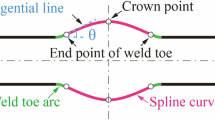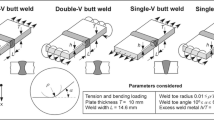Abstract
Industry design standards such as BS 7910 deployed some empirical formulas for the prediction of stress intensity factor (SIF) based on simulation results from traditional finite element method (FEM). However, such FEM simulation occasionally failed to convince people due to the large discrepancies compared with engineering practice. As a consequence, inaccuracy predictions via such formulas in engineering standards inevitably occur, which will compromise the safety of structures. In our previous research work, an abnormal phenomenon of SIF in a cracked T-butt joint accounting for welding effect has been observed. Compared with BS 7910, the calculation results of SIF at the surface points of welded specimens cannot be well predicted, with a large discrepancy appearing. In order to explore such problem with an abnormal increase at the surface points of cracked welded specimens, a numerical investigation in terms of SIF among BS 7910, XFEM, and FEM is performed in this paper. Numerical models on both a simple cracked plate without welding effect and a cracked T-butt joint with welding effect are developed through ABAQUS. Parametric studies in terms of the effects of varied crack depth to thickness ratio (a/T) and the effects of crack depth to crack half-length ratio (a/c) are carried out. Empirical solutions from BS 7910 are used for comparison. It is found that the XFEM can provide predictions of SIF at both the crack deepest point and crack surface point of a simple cracked plate as accurate as FEM. For a T-butt joint with a transverse stiffener, a large discrepancy in terms of the weld magnification factors (Mk) occurs at the crack surface point compared with empirical predictions. An exceptional increase of von Mises stress gradient in regions close to the weld-toe is found through the simulation of FEM, whereas a constant stress gradient is obtained through XFEM. The comparison results indicate an inappropriate prediction of SIF by the utilization of the empirical formulas in BS 7910. A more reasonable prediction of the SIF at the surface point of a crack is obtained by the XFEM. Therefore, further updating of the empirical solutions in BS 7910 for SIF accounting for welding effect is recommended.













Similar content being viewed by others
References
Alessi L, Correia J, Fantuzzi N (2019) Initial design phase and tender designs of a jacket structure converted into a retrofitted offshore wind turbine. Energies 12(4):1–28
Areias P, Belytschko T (2005a) Analysis of three-dimensional crack initiation and propagation using the extended finite element method. Int J Numer Methods Eng 63(5):760–788
Areias P, Belytschko T (2005b) Non-linear analysis of shells with arbitrary evolving cracks using xfem. Int J Numer Methods Eng 62(3):384–415
Belytschko T, Black T (1999) Elastic crack growth in finite elements with minimal remeshing. Int J Numer Methods Eng 45(5):601–620
Bergara A, Dorado J, Martin-Meizoso A, Martínez-Esnaola J (2017) Fatigue crack propagation in complex stress fields: Experiments and numerical simulations using the extended finite element method (XFEM). Int J Fatigue 103:112–121
Bowness D, Lee M (1996) Stress intensity factor solutions for semi-elliptical weld-toe cracks in T-butt geometries. Fatigue Fract Eng Mater Struct 19(6):787–797
Bowness D, Lee M (2000) Prediction of weld toe magnification factors for semi-elliptical cracks in T–butt joints. Int J Fatigue 22(5):369–387
BSI (2015) Guide to methods for assessing the acceptability of flaws in metallic structures. Tech. Rep. BS 7910:2013+A1:2015, British Standards Institute, # 14. https://doi.org/10.3403/30241230
Cai J, Jiang X, Lodewijks G (2017) Residual ultimate strength of offshore metallic pipelines with structural damage–a literature review. Ships and Offshore Structures, 1037–1055
Cai J, Jiang X, Lodewijks G, Pei Z, Wu W (2018a) Residual ultimate strength of damaged seamless metallic pipelines with combined dent and metal loss. Marine Structures 61:188–201
Cai J, Jiang X, Lodewijks G, Pei Z, Wu W (2018b) Residual ultimate strength of damaged seamless metallic pipelines with metal loss. Marine Structures 58:242–253
Cai J, Jiang X, Lodewijks G, Pei Z, Wu W (2018c) Residual ultimate strength of seamless metallic pipelines under a bending moment - a numerical investigation. Ocean Engineering 164:148–159
da Silva AL, Correia J, de Jesus AM, Lesiuk G, Fernandes A, Calçada R, Berto F (2019) Influence of fillet end geometry on fatigue behaviour of welded joints. Int J Fatigue 123:196–212
Dake Y, Sridhar I, Zhongmin X, Kumar SB (2012) Fracture capacity of girth welded pipelines with 3D surface cracks subjected to biaxial loading conditions. Int J Press Vessel Pip 92:115–126
Dolbow J, Moës N, Belytschko T (2001) An extended finite element method for modeling crack growth with frictional contact. Computer Methods Appl Mech Eng 190(51-52):6825–6846
Gifford Jr LN, Hilton PD (1978) Stress intensity factors by enriched finite elements. Engineering Fracture Mechanics 10(3):485–496
Giner E, Sukumar N, Denia F, Fuenmayor F (2008) Extended finite element method for fretting fatigue crack propagation. Int J Solids Struct 45(22-23):5675–5687
Li Z, Jiang X, Hopman H, Zhu L, Liu Z (2020) An investigation on the circumferential surface crack growth in steel pipes subjected to fatigue bending. Theor Appl Fract Mech 105:102403
Lin X, Smith R (1999) Finite element modelling of fatigue crack growth of surface cracked plates: Part III: Stress intensity factor and fatigue crack growth life. Eng Fract Mech 63(5):541–556
Melenk JM, Babuška I (1996) The partition of unity finite element method: basic theory and applications. Comput Methods Appl Mech Eng 139(1-4):289–314
Moës N, Dolbow J, Belytschko T (1999) A finite element method for crack growth without remeshing. Int J Numer Methods Eng 46(1):131–150
Newman Jr J, Raju I (1979) Analysis of surface cracks in finite plates under tension or bending loads. Tech. rep., Langley Research Center, Virginia, United States, NASA Technical Paper 1578
Newman Jr J, Raju I (1981) An empirical stress-intensity factor equation for the surface crack. Eng Fract Mech 15(1-2):185–192
Paris PC, Gomez MP, Anderson WE (1961) A rational analytic theory of fatigue. The Trends of Engineering 13:9–14
Schijve J (2001) Fatigue of structures and materials. Springer Science & Business Media
Shi J, Chopp D, Lua J, Sukumar N, Belytschko T (2010) Abaqus implementation of extended finite element method using a level set representation for three-dimensional fatigue crack growth and life predictions. Engineering Fracture Mechanics 77(14):2840–2863
Shipley RJ, Becker WT (2002) Failure analysis and prevention. ASM Handbook 11, 508
Shiratori M, Miyoshi T (1986) Analysis of stress intensity factors for surface cracks subjected to arbitrarily distributed stresses. In: Computational Mechanics’ 86. Springer, pp 1027–1032
Silva A, De Jesus A, Xavier J, Correia J, Fernandes A (2017) Combined analytical-numerical methodologies for the evaluation of mixed-mode (I+ II) fatigue crack growth rates in structural steels. Eng Fract Mech 185:124–138
Simulia D (2016) ABAQUS v6.14 - Documentation. ABAQUS. http://130.149.89.49:2080/v6.14/
Singh I, Mishra B, Bhattacharya S, Patil R (2012) The numerical simulation of fatigue crack growth using extended finite element method. Int J Fatigue 36(1):109–119
Sukumar N, Moës N, Moran B, Belytschko T (2000) Extended finite element method for three-dimensional crack modelling. Int J Numer Methods Eng 48(11):1549–1570
Sukumar N, Prévost J-H (2003) Modeling quasi-static crack growth with the extended finite element method part I: Computer implementation. Int J Solids Struct 40(26):7513–7537
Ventura G, Budyn E, Belytschko T (2003) Vector level sets for description of propagating cracks in finite elements. Int J Numer Methods Eng 58(10):1571–1592
Wang X (2002) Stress intensity factors and weight functions for deep semi-elliptical surface cracks in finite-thickness plates. Fatigue Fract Eng Mater Struct 25(3):291–304
Zettlemoyer N, Fisher J (1977) Stress gradient correction factor for stress intensity at welded stiffeners and cover plates. Welding Journal 56(12):3938–3985
Zhang Y, Tan T, Xiao Z, Zhang W, Ariffin M (2016) Failure assessment on offshore girth welded pipelines due to corrosion defects. Fatigue Fract Eng Mater Struct 39(4):453–466
Acknowledgements
Thanks to Rob Pijper and Rene Bakker from Lloyd’s Register in Rotterdam, who have provided great support for this project.
Author information
Authors and Affiliations
Corresponding author
Additional information
Publisher’s Note
Springer Nature remains neutral with regard to jurisdictional claims in published maps and institutional affiliations.
Article Highlights
∙ An abnormal phenomenon of SIF in a cracked T-butt joint accounting for welding effect has been observed and investigated.
∙ Compared to BS7910, the large discrepancy of SIF at the surface points of the welded T-butt joints with semi-elliptical cracks has been numerically investigated by both XFEM and FEM. ∙ Parametric studies in terms of the varied crack depth to thickness ratio and the crack depth to crack half-length ratio are carried out.
∙ The research in this paper indicates a possible inaccuracy estimation of SIF at the crack surface point in a T-butt joint by BS7910, which requires a potential updating.
Rights and permissions
About this article
Cite this article
Schiaretti, M., Cai, J., Jiang, X. et al. A Numerical Investigation of an Abnormal Phenomenon of Stress Intensity Factor (SIF) in a Cracked T-Butt Joint Accounting for Welding Effect. J. Marine. Sci. Appl. 20, 343–353 (2021). https://doi.org/10.1007/s11804-021-00199-x
Received:
Accepted:
Published:
Issue Date:
DOI: https://doi.org/10.1007/s11804-021-00199-x




